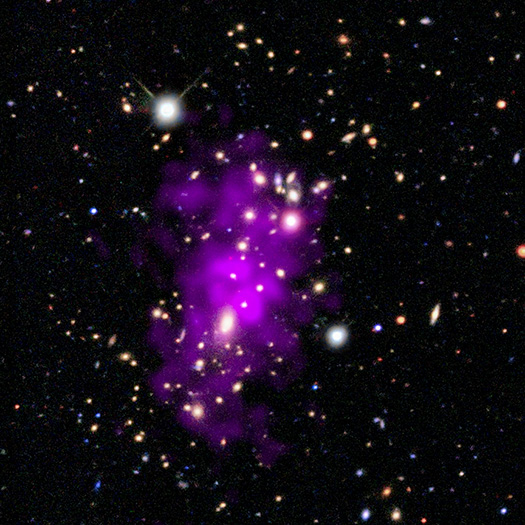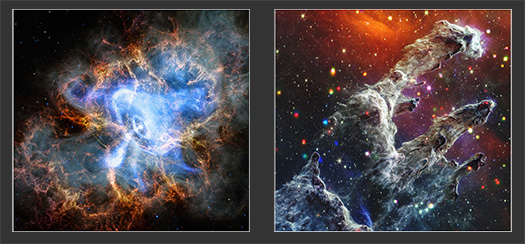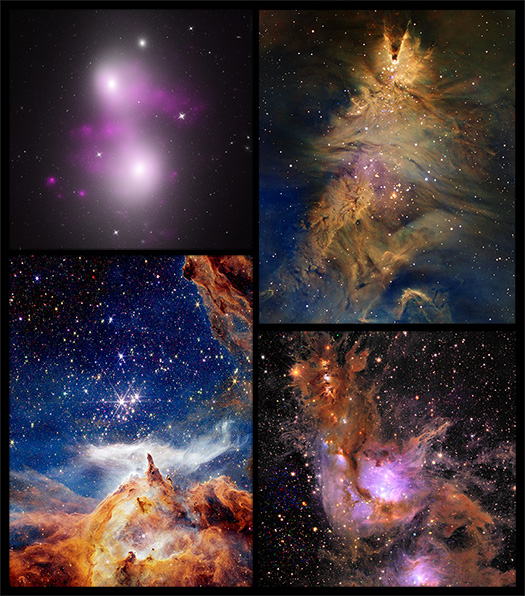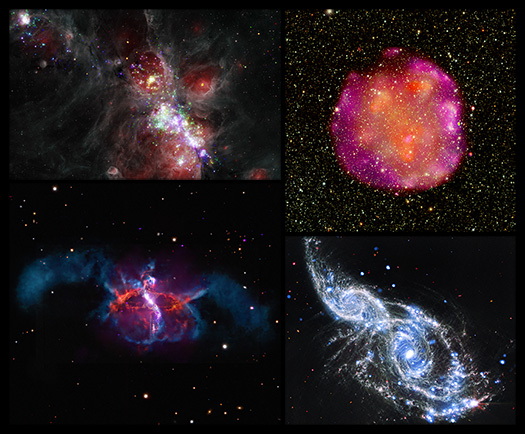Supernova Remnant Video From NASA's Chandra Is Decades in Making
Your browser does not support the video tag.
Kepler’s Supernova Remnant
More images, videos, and information
X-ray: NASA/CXC/SAO; Optical: Pan-STARRS
A new video shows changes in Kepler’s Supernova Remnant using data from NASA’s Chandra X-ray Observatory captured over more than two and a half decades with observations taken in 2000, 2004, 2006, 2014, and 2025. In this video, which is the longest-spanning one ever released by Chandra, X-rays (blue) from the telescope have been combined with an optical image (red, green, and blue) from Pan-STARRS.
Kepler’s Supernova Remnant, named after the German astronomer Johannes Kepler, was first spotted in the night sky in 1604. Today, astronomers know that a white dwarf star exploded when it exceeded a critical mass, after pulling material from a companion star, or merging with another white dwarf. This kind of supernova is known as a Type Ia and scientists use it to measure the expansion of the Universe.
NASA's Chandra Rings in New Year With Champagne Cluster

Champagne Cluster
More images, videos, and information
Credit: X-ray: NASA/CXC/UCDavis/F. Bouhrik et al.; Optical:Legacy Survey/DECaLS/BASS/MzLS;
Image Processing: NASA/CXC/SAO/P. Edmonds and L. Frattare
Celebrate the New Year with the “Champagne Cluster,” a galaxy cluster seen in this new image from NASA’s Chandra X-ray Observatory and optical telescopes.
Astronomers discovered this galaxy cluster Dec. 31, 2020. The date, combined with the bubble-like appearance of the galaxies and the superheated gas seen with Chandra observations (represented in purple), inspired the scientists to nickname the galaxy cluster the Champagne Cluster, a much easier-to-remember name than its official designation of RM J130558.9+263048.4.
Cosmic Holiday Greetings From NASA's Chandra X-ray Observatory
NASA’s Chandra X-ray Observatory is sending out a holiday card with four new images of cosmic wonders. Each of the quartet of objects evokes the winter season or one of its celebratory days either in its name or shape.
Chandra’s seasonal greetings begin with NGC 4782 and NGC 4783, a pair of colliding galaxies when oriented in a certain way resembles a snowman. The top and bottom of the snowman are each elliptical galaxies, separated by a distance of about 170 million light-years. The galaxies, seen in an image from NASA’s Hubble Space Telescope (gray), are bound together through gravity. X-rays from Chandra (purple) show a bridge of hot gas between the two galaxies, like a winter scarf.
New Project Celebrates Views of the Very Big and Very Small
A new project from the Chandra X-ray Observatory reveals stunning connections between the vast universe and the microscopic world that we cannot see with the naked eye.
Chandra is one of NASA’s “Great Observatories”, which include the Hubble and James Webb Space Telescopes, that has offered unparalleled X-ray images of the cosmos for over a quarter century. Scientists regularly use Chandra, which is operated by the Smithsonian Astrophysical Observatory, in concert with other telescopes on the ground and in space.
Chandra’s “New Perspectives” project takes these space-based images and creates side-by-side comparisons with winning images from the Nikon Small World contest. The results from the latest Nikon Small World contest, an annual free microscopy competition, were announced in October 2025.
The goal of New Perspectives is to provide a new way to look at images from science — and realize the benefits from looking at our world from different points of view.
NASA's Chandra Finds Small Galaxies May Buck the Black Hole Trend

NGC 6278 and PGC 039620
More images, videos, and information
Credit: X-ray: NASA/CXC/SAO/F. Zou et al.; Optical: SDSS; Image Processing: NASA/CXC/SAO/N. Wolk
This two-panel graphic represents the results of a new study that suggests that smaller galaxies do not contain supermassive black holes nearly as often as larger galaxies do. The new study, as described in our latest press release, analyzed over 1,600 galaxies that have been observed with NASA’s Chandra X-ray Observatory over two decades. The findings imply that most smaller galaxies likely do not have supermassive black holes in their centers, which is in contrast with the common idea that nearly every galaxy has one of these giant black holes within their cores.
The two galaxies shown here, NGC 6278 and PGC 039620, are representative of the galaxies in the study. In optical and X-ray images (X-rays are purple), both galaxies are seen in optical light data from the Sloan Digital Sky Survey. The insets contain just the X-ray data from Chandra. NGC 6278 is roughly the same size as our home galaxy and has X-rays detected from its core. PGC 03620 on the other hand is a smaller galaxy — only a fraction of the size of the Milky Way — and does not show any evidence of an X-ray source.
Painting Galaxy Clusters by Numbers (and Physics)

Five Galaxy Clusters in the Sample
More images, videos, and information
Credit: X-ray: NASA/CXC/Univ. of Chicago/H. McCall
Galaxy clusters are the most massive objects in the Universe held together by gravity, containing up to several thousand individual galaxies and huge reservoirs of superheated, X-ray-emitting gas. The mass of this hot gas is typically about five times higher than the total mass of all the galaxies in galaxy clusters. In addition to these visible components, 80% of the mass of galaxy clusters is supplied by dark matter. These cosmic giants are bellwethers not only for the galaxies, stars and black holes within them, but also for the evolution and growth of the Universe itself.
It is no surprise then that NASA’s Chandra X-ray Observatory has observed many galaxy clusters over the lifetime of the mission. Chandra’s X-ray vision allows it to see the enormous stockpiles of hot cluster gas, with temperatures as high as 100 million degrees, with exquisite clarity. This blazing gas tells stories about past and present activity within galaxy clusters.
From Space to the Stage: New Symphony Inspired by NASA's Chandra
A new symphony based on data from NASA’s Chandra X-ray Observatory, as well as the James Webb Space Telescope, transforms astronomical observations into music that traces the life cycle of stars.
While there have been many original pieces of music inspired by the heavens, this musical composition is uniquely mapped from data of space. By using data sonifications from Chandra, compiled with Webb data, of both the Crab Nebula and Pillars of Creation (M16), this new composition provides an unprecedented connection to space through music via actual data.

The Crab Nebula (left) from NASA’s Chandra and Webb telescopes is the data behind the piece “Return to Dust” and the Pillars of Creation (M16, right) from Chandra and Webb is the data behind the piece “Cathedrals of Dust & Light”
The Chandra X-ray Observatory is one of NASA’s “Great Observatories” and has been the world’s premier X-ray telescope for over a quarter century. It also leads in the innovative use of data sonification—the process of converting scientific data into sound.
This new two-part suite by composer Sophie Kastner builds on and pairs with her previous work, “Where Parallel Lines Converge,” which was based on the Chandra data sonification of the Galactic Center. In both the original composition and this latest 2-piece suite, Kastner has created musical vignettes that human musicians can play based on the NASA data and how it is represented in the sonification.
Fall Collection: Before Fall Leaves, See Seasonal Offerings from NASA's Chandra
Before fall gives way to winter in the northern hemisphere, NASA’s Chandra X-ray Observatory has several images that celebrate autumn and its many delights to share. In spirit of the season, this collection gathers Chandra data with those from its telescopic family including NASA’s James Webb, Hubble, and Spitzer Space Telescopes, plus others in space and on the ground.
Searching for Betelgeuse’s Buddy with Chandra
We welcome Brendan O'Connor and Anna O’Grady as guest bloggers. They write about their new study as described in a press release from Carnegie Mellon University (CMU).
O’Connor is a McWilliams Fellow in the McWilliams Center for Cosmology and Astrophysics at CMU, where he studies cosmic explosions. His research focuses on time-domain and transient astrophysics with a focus on the formation and evolution of high-energy transients and their progenitors. He uses a range of optical, infrared, and X-ray observatories to investigate these phenomena across the electromagnetic spectrum and is an avid user of NASA’s Chandra X-ray Observatory. He received his PhD from The George Washington University in 2023 under the supervision of Dr. Chryssa Kouveliotou, Dr. Eleonora Troja, and Dr. Brad Cenko.
Anna O’Grady is also a McWilliams fellow at CMU. She previously completed her PhD at the University of Toronto under the supervision of Maria Drout and Bryan Gaensler and obtained her BSc. from Memorial University of Newfoundland and Labrador. She is an observational stellar astrophysicist who studies resolved stellar populations in the Milky Way and nearby galaxies, with a focus on constraining the binary evolution of massive stars.

Photo: Anna O’Grady and Brendan O'Connor, astronomers from CMU.
Our Nearest Big Red Neighbor
Betelgeuse — visible in the winter in the Northern hemisphere and the summer in the Southern hemisphere as the bright orange-red star in Orion’s right shoulder — is the closest red supergiant to Earth. It is a massive star, about 18 times the mass of our Sun, and astronomers predict that it will one day explode in a spectacular supernova explosion.
Chandra Reveals an Extremely Fast Accreting Black Hole in the Early Universe
We are happy to welcome Luca Ighina as a guest blogger. Luca is a postdoctoral fellow at the Center for Astrophysics | Harvard and Smithsonian and the first author of a paper that is the subject of our latest Chandra press release. In his research he studies the most distant supermassive black holes with a focus on those able to expel part of the material they are pulling inwards in the form of jets moving at close to the speed of light. To this end he uses the most sensitive telescopes around the world covering the entire electromagnetic spectrum, from the radio to the optical-near-infrared to the X-ray band. He received his PhD from the Insubria University (Como, Italy), where he mainly worked at the INAF institute in Milano-Brera (Italy), along with a one-year visit to the ICRAR institute for radio astronomy in Perth (Western Australia).
How do supermassive black holes grow in the early Universe?
Most galaxies observed in the Universe host a supermassive black hole at their center. Some of them, called active galactic nuclei (AGN) or quasars, grow in mass as surrounding material falls inwards through a process called accretion. Astronomers have found some extreme examples of quasars that can reach masses of several billion times that of the Sun, only one billion years after the Big Bang. Understanding how these black holes formed and grew so rapidly remains one of the major open questions in modern astrophysics.




